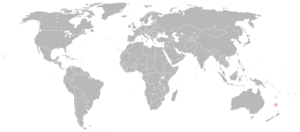Norfolk tree fern facts for kids
Quick facts for kids Norfolk tree fern |
|
|---|---|
 |
|
| Scientific classification | |
| Synonyms | |
|
The Norfolk tree fern is a giant fern. It might even be the biggest fern in the world! It only grows naturally on Norfolk Island. This island is in the Pacific Ocean, close to Australia and New Zealand.
Its scientific names are Sphaeropteris excelsa or Cyathea brownii. A botanist named Robert Brown gave it its name.
Contents
What Does the Norfolk Tree Fern Look Like?
This fern can grow super tall, over 20 meters (about 65 feet)! That's like a seven-story building. Its huge leaves are called fronds. These fronds can be up to 5 meters (16 feet) long. They are wide and shaped like a spear.
The stem of the frond is called a stipe. It has white, stitch-like marks. Both the stipe and the main stem of the frond (rachis) have scales. These scales are white-brown and orange-brown. The main trunk of the fern gets smooth as it gets older. It shows oval marks where old fronds used to be.
Where Does the Norfolk Tree Fern Live?
The Norfolk tree fern naturally grows in rainforests. These forests are found on Norfolk Island. The weather there is warm and humid.
In summer, the average daytime temperature is about 23°C (73°F). In winter, it drops to about 17°C (63°F). The highest temperature is around 29°C (84°F). The lowest is about 6°C (43°F). The air is very humid all year, usually between 70% and 80%. Norfolk Island gets about 1200 mm (47 inches) of rain each year.
Protecting the Norfolk Tree Fern
Most of the old forests on Norfolk Island are gone. But a small part is now a national park. The Norfolk tree fern is safe inside this park. You can also find this fern growing in gardens in many countries. It is not considered an endangered plant.
How to Grow a Norfolk Tree Fern
People grow the Norfolk tree fern as an ornamental plant. This means it's grown for its beauty. It needs soil that is a bit acidic or neutral. The soil should have lots of organic matter. It must hold water well but also drain easily. This fern does not like to sit in soggy soil.
The Norfolk tree fern needs a lot of humidity. It also needs frequent watering or lots of rain. A young fern in a pot can drink half a liter (about half a quart) of water every day in summer!
This fern likes good light. But it grows best if it's shaded during the hottest part of the day. It grows well with plant food. However, some store-bought fertilizers can make its fronds look strange. They might make the plant bigger but weaker.
The Norfolk tree fern can only handle light frost. Larger plants might survive temperatures as low as -3°C (27°F) for a short time. In colder places like Britain, it's best to grow them in a conservatory. But they get very big, so this can be hard. It's a beautiful plant, but it needs a lot of care in cold areas.
You can easily grow new ferns from their spores. Young plants can grow very fast!
Images for kids



